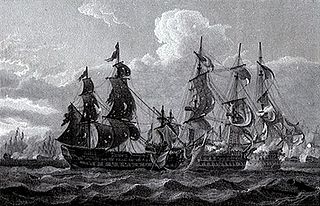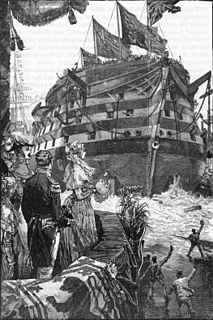This article includes a list of references, related reading or external links, but its sources remain unclear because it lacks inline citations .(February 2013) (Learn how and when to remove this template message) |
 The shipwreck of the Minotaur , oil on canvas, by J. M. W. Turner | |
| Class overview | |
|---|---|
| Name: | Courageux |
| Operators: | |
| Preceded by: | Gangesclass |
| Succeeded by: | Marsclass |
| In service: | 21 January 1783 - 1848 |
| Completed: | 8 |
| Lost: | 2 |
| General characteristics | |
| Type: | Ship of the line |
| Length: |
|
| Beam: |
|
| Propulsion: | Sails |
| Armament: |
|
| Notes: | Ships in class include: Carnatic, Colossus, Leviathan, Minotaur, Aboukir, Bombay, Blake, San Domingo |
The Courageux-class ships of the line were a class of six 74-gun third rates of the Royal Navy. Their design was a direct copy of the French ship Courageux, captured in 1761 by HMS Bellona. This class of ship is sometimes referred to as the Leviathan class. A further two ships of the class were built to a slightly lengthened version of the Courageux draught. A final two ships were ordered to a third modification of the draught.

The Royal Navy (RN) is the United Kingdom's naval warfare force. Although warships were used by the English kings from the early medieval period, the first major maritime engagements were fought in the Hundred Years War against the Kingdom of France. The modern Royal Navy traces its origins to the early 16th century; the oldest of the UK's armed services, it is known as the Senior Service.
Courageux was a heavy 74-gun ship-of-the-line of the French Navy, launched in 1753. She was captured by the Royal Navy in 1761 and taken into service as HMS Courageux. In 1778, she joined the Channel Fleet and later, was part of the squadron commanded by Commodore Charles Fielding, that controversially captured a Dutch convoy on 31 December 1779, in what became known as the Affair of Fielding and Bylandt. On 4 January 1781, Courageux was west of Ushant, when she recaptured Minerva in a close range action that lasted more than an hour. The following Spring, Courageux joined the convoy, under George Darby, which successfully relieved the besieged Gibraltar.
HMS Bellona was a 74-gun Bellona-class third-rate ship of the line of the Royal Navy. Designed by Sir Thomas Slade, she was a prototype for the iconic 74-gun ships of the latter part of the 18th century. "The design of the Bellona class was never repeated precisely, but Slade experimented slightly with the lines, and the Arrogant, Ramillies, Egmont, and Elizabeth classes were almost identical in size, layout, and structure, and had only slight variations in the shape of the underwater hull. The Culloden class ship of the line was also similar, but slightly larger. Thus over forty ships were near-sisters of the Bellona." Bellona was built at Chatham, starting on 10 May 1758, launched on 19 February 1760, and commissioned three days later. She was the second ship of the Royal Navy to bear the name, and saw service in the Seven Years' War, American Revolutionary War and the Napoleonic Wars.



















